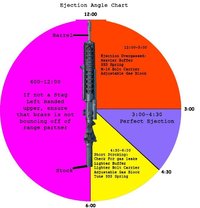I really didn’t pay any attention to this aspect of the AR type until I was doing my .50 Beowulf build. Not really understanding the details, I was thinking with the hard hitting .50 caliber, you’d need a heavy buffer spring and buffer. It wasn’t until I read Alexander Arms F.A.Q. that I realized that the buffer spring and buffer you should use are completely dependent on the chamber pressure of the cartridge and the dwell time. What you realize with the .50 Beowulf is that the chamber pressure of 33,000 psi is considerably less than the 5.56 NATO chamber pressure of 58,000 psi, but it kind of makes up for that lower pressure with a longer dwell time (since that heavy built takes longer to accelerate down the barrel). The combination of the lower pressure, using the correct sized gas port and the longer dwell time means that the .50 Beowulf uses a standard strength carbine spring along with an H2 buffer (or a standard rifle spring with 5.2 oz rifle buffer for a rifle length stock).
As Alexander Arms says:
The AR-15 buffer and buffer spring are used only for the cycling of ammunition inside of the rifle. Recoil in an AR-15 rifle is almost entirely unrelated to the buffer components, especially with .50 Beowulf®. You can thank the 1,300 MPH projectile exiting the other end for the recoil.
And while the dwell time will be measure in milliseconds, you can get a good idea how well your particular rifle is timed based on its ejection pattern. 80% Arms gives you one of the many ejection pattern charts:

Unless you have an adjustable gas block, most people won’t want to mess with the barrel’s gas port or gas block, so you’ll be messing with your buffer spring and buffer weight. Note that this doesn’t fully correct for incorrect gassing, it just mitigates it.
And here is another good article on dwell time (though the author does use the simplified version of its definition):
what-is-dwell-time
The author points out that the “average" commercial AR is actually overgassed so that they will run with the lowest quality 5.56/.223 ammo, but that the overgassing will really only effect them after several 1000 rounds where as the “average” AR won’t see near that many rounds. That’s might be why some of the high end ARs run poorly with the cheap ammo. They actually are properly gassed to only work with high quality ammo.

